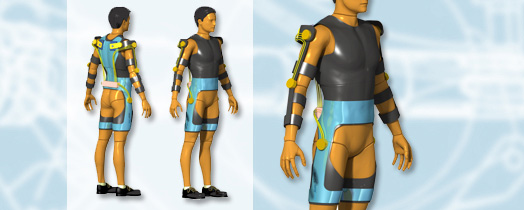Milestones in Human-Machine Cooperation

Enhanced Robo-Mate design concept © ZHAW (Zürcher Hochschule für Angewandte Wissenschaften)
Just a little over a year has passed since BBC News ranked the Robo-Mate exoskeleton at No. 2,right after the announcement of the new iPhone, and major technical progress has been made on several fronts.
A key focus of the initial twelve months of the EU-funded Robo-Mate project was to define the various production processes of end-users from different industries (e.g. automotive, automotive components, dismantling, and scrap recycling). This has allowed the project consortium of 13 partners from academia and industry to identify their needs from both a worker and a business perspective.
One of the major achievements on the industrial end was detailing two specific use-cases for the exoskeleton with a potentially high impact for the end-user partners (CRF, COMPA and INDRA). The use-cases support one and two handed manipulation of objects up to 7.5kg and 15kg, respectively.
On the worker end, design experts, human factors specialists and end-users teamed-up and concentrated efforts on what workers need to more efficiently and safely perform tasks, particularly in heavy and repetitive lifting. The Robo-Mate exoskeleton design consists of a core, anthropomorphic trunk-module that reduces compression forces in the lower back and provides a base for arm and leg extensions of varying complexity.
These modules can be passive, partially or fully activated, and anthropomorphic, or not, depending on the required use. Furthermore, Robo-Mate will be outfitted with tag readers, radio-frequency tracking (RFID), or other work-piece identification systems, as well as the inclusion of heads-up displays and vision recognition to maximise direct interaction with the production process. Safety is tantamount; therefore, the system will ensure the highest possible level of safety, even in uncertain and dynamic manufacturing environments.
The next major project milestones going forward involve putting prototypes to work and evaluating them. To that end, in the first quarter of 2015, the Zurich University of Applied Science (ZHAW) and the Italian Institute of Technology (IIT) will produce and test the first subsystem prototypes.
At the same time, the Fraunhofer Institute for Industrial Engineering IAO is simulating the production processes of our end-users to ensure that Robo-Mate is used most effectively and to assess the impact on productivity and on ergonomics-driven workplace design. The coupling of the exoskeleton models to the software system Classic Jack of Siemens PLM software and the enhancement of Siemens Process Simulate with new manufacturing resources represent the innovative research activities performed by Fraunhofer IAO as well.
And of course, with the crux of the Robo-Mate project centred on user-friendly interactive human-robot cooperation in industrial environments, workers will play a significant role in this process. In the summer of 2015, representatives from selected industries will participate in a prototype workshop at one of the end-users’ facilities.
Overall, the project is effectively moving along and striding towards realising and impacting earmarked objectives in the industrial workplace related to safety and improved working conditions, greater production efficiency and higher productivity. Thanks to Robo-Mate, the interactive, safe and competitive factories of the future are coming ever closer.
Contact:
Hon.-Prof. Dr. Carmen Constantinescu
Digital Engineering
Fraunhofer IAO
Nobelstraße 12
70569 Stuttgart, Germany
Phone +49 711 970-2282
carmen.constantinescu@iao.fraunhofer.de
Weitere Informationen:
Media Contact
All latest news from the category: Information Technology
Here you can find a summary of innovations in the fields of information and data processing and up-to-date developments on IT equipment and hardware.
This area covers topics such as IT services, IT architectures, IT management and telecommunications.
Newest articles

Bringing bio-inspired robots to life
Nebraska researcher Eric Markvicka gets NSF CAREER Award to pursue manufacture of novel materials for soft robotics and stretchable electronics. Engineers are increasingly eager to develop robots that mimic the…

Bella moths use poison to attract mates
Scientists are closer to finding out how. Pyrrolizidine alkaloids are as bitter and toxic as they are hard to pronounce. They’re produced by several different types of plants and are…

AI tool creates ‘synthetic’ images of cells
…for enhanced microscopy analysis. Observing individual cells through microscopes can reveal a range of important cell biological phenomena that frequently play a role in human diseases, but the process of…





















